National Scientific Funding for Interdisciplinary Research: A Comparison Study of Infectious Diseases in the US and EU
Abstract
1. Introduction
- What interdisciplinary fields of research on infectious diseases have the US and EU invested in since 2015?
- What are the disciplinary ranges in infectious diseases-related research fields in the US and EU?
- How does the US and the EU differ in their interdisciplinary research approaches to infectious diseases?
2. Materials and Methods
2.1. Data Collection
2.2. Data Preprocessing
2.3. Cooccurrence Matrix
2.4. Clustering and Network Visualisation
2.5. Defining an Interdisciplinary R&D Area
3. Results
3.1. Interdisciplinary Research Areas on Infectious Diseases Funded by the US
3.1.1. Public Health for HIV-Vulnerable Group/Respiratory Health for Children/HR for Infectious Diseases (Cluster 1)
3.1.2. Diagnosis and Treatment of Infectious Diseases by Using Advanced Technology (Cluster 2)
3.1.3. Biological Studies on the Mechanism of Inflammatory Diseases Caused by Infectious Diseases and the Development of Therapies for Them (Cluster 3)
3.1.4. Strengthening Research Capacity for Epidemiology (Cluster 4)
3.1.5. Clinical Trials on Vaccines and Products to Help Treat and Prevent Infectious Diseases (Cluster 5)
3.2. Fields of Interdisciplinary Research on Infectious Diseases Funded by the EU
3.2.1. Detection and Profiling for Pathogens (Cluster 1)
3.2.2. Public Health Policy and Infrastructure for the Prevention and Treatment of Infectious Diseases (Cluster 2)
3.2.3. Immunological Studies on Infectious Diseases (Cluster 3)
3.2.4. Development of Vaccine and Vaccine-Related Products (Cluster 4)
3.3. Comparison between the US and EU
4. Discussion and Conclusions
Author Contributions
Funding
Conflicts of Interest
Appendix A
| Cluster No. | Sub-Cluster No. | # of ASJC Codes in Sub-Cluster | Component ASJC Code (Main) | Component ASJC Code (Coordinated) | # of R&D Projects | The Total Cost of R&D Projects ($) | Major Organisation Performing Projects |
|---|---|---|---|---|---|---|---|
| 1. Public health for HIV-vulnerable group/Respiratory health for children/HR for infectious diseases | 1-1 HIV | 7 | Health Policy (2719) Nursing (miscellaneous) (2901) Oncology(nursing) (2917) Psychiatric Mental Health (2921) | Social Psychology (3207) Health (social science) (3306) Communication (3315) | 34 | 4,351,252 | University of North Carolina Chapel Hill Duke University University of Minnesota Twin Cities University of Missouri-Columbia University of Chicago Yale University Infectious Diseases Institute University of Wisconsin Madison |
| 1-2 Heath assessment of children | 5 | Medicine (miscellaneous) (2701) Epidemiology (2713) Obstetrics and Gynaecology (2729) | Public Health, Environmental and Occupational Health (2739) Radiation (3108) | 2 | 3,530,344 | University of Utah | |
| 1-3 Research scholar and educational programs | 9 | Earth-Surface Processes (1904) Paediatrics (2919) Review and Exam Preparation (2923) Pharmacology, Toxicology and Pharmaceutics (miscellaneous) (3001) | Social Sciences (miscellaneous) (3301) Education (3304) Health Professions (miscellaneous) (3601) Complementary and Manual Therapy (3603) Emergency Medical Services (3604) | 10 | 1,389,374 | Colorado State University-Fort Collins Tufts University Boston | |
| 2. Diagnosis and treatment of infectious diseases by using advanced technology | 2-1 Information technology-based infectious disease diagnosis | 15 | Management Information Systems (1404) Computer Science (miscellaneous) (1701) Computational Theory and Mathematics (1703) Computer Networks and Communications (1705) Hardware and Architecture (1708) Human-Computer Interaction (1709) Information Systems (1710) Signal Processing (1711) | Space and Planetary Science (1912) Biomedical Engineering (2204) Electrical and Electronic Engineering (2208) Computational Mathematics (2605) Health Informatics (2718) Health Information Management (3605) Radiological and Ultrasound Technology (3614) | 12 | 12,041,079 | The University of Pittsburgh Cornell University Ithaca Advanced Microsensors Corporation City College of New York Georgia Tech Research Corporation Research Triangle Institute University of Oklahoma Norman University of Utah |
| 2-2 Molecular biology-based diagnosis and treatment | 13 | Biochemistry (1303) Biophysics (1304) Biotechnology (1305) Physiology (1314) Structural Biology (1315) Bioengineering (1502) Inorganic Chemistry (1604) | Organic Chemistry (1605) Spectroscopy (1607) Polymers and Plastics (2507) Statistics and Probability (2613) Drug Discovery (3002) Pharmaceutical Science (3003) | 19 | 5,532,582 | Washington University The Johns Hopkins University Nubad Llc University of Arizona University of Michigan At Ann Arbor University of Rochester Adjuvance Technologies Inc University of Oklahoma Norman Zata Pharmaceuticals Inc | |
| 2-3 Wastewater treatment for preventing infectious diseases | 5 | Fluid Flow and Transfer Processes (1507) Process Chemistry and Technology (1508) Geotechnical Engineering and Engineering Geology (1909) | Ecological Modelling (2302) Management, Monitoring, Policy and Law (2308) | 1 | 332,441 | Rutgers State University of New Jersey—New Brunswick | |
| 2-4 Eye disease stemmed from infectious diseases | 5 | Strategy and Management (1408) Management Science and Operations Research (1408) Engineering (miscellaneous) (2201) | Cardiology and Cardiovascular Medicine (2705) Oral Surgery (3504) | 1 | 399,420 | University of California San Francisco | |
| 3. Biological studies on the mechanism of inflammatory diseases caused by infectious diseases and the development of therapies | 3-1 Inflammation treatments caused by infectious diseases | 20 | Biochemistry, Genetics and Molecular Biology (miscellaneous) (1301) /Cancer Research (1306) Cell Biology (1307) Molecular Biology (1312) Molecular Medicine (1313) Immunology (2403) Embryology (2710) Gastroenterology (2715) Genetics(clinical) (2716) Hepatology (2721) | Immunology and Allergy (2723) Nephrology (2727) Otorhinolaryngology (2733) Physiology (medical) (2737) Reproductive Medicine (2743) Rheumatology (2745) Transplantation (2747) Endocrine and Autonomic Systems (2807) Toxicology (3005) Periodontics (3506) | 103 | 31,226,545 | University of Colorado Denver H Lee Moffitt Cancer Center & Research Institute Harvard School of Public Health University of North Carolina Chapel Hill University of Washington Dartmouth College Massachusetts General Hospital The University of Pittsburgh Harvard University Keystone Symposia. Etc. |
| 3-2 sleepy sickness | 5 | Insect Science (1109) Developmental Biology (1309) Genetics (1311) | Ecology (2303) Cellular and Molecular Neuroscience (2804) | 4 | 416,250 | Yale University | |
| 3-3 viral diseases in human and animals | 10 | Animal Science and Zoology (1103) Environmental Science (miscellaneous) (2301) Immunology and Microbiology (miscellaneous) (2401) Applied Microbiology and Biotechnology (2402) Parasitology (2405) | Virology (2406) Infectious Diseases (2725) Microbiology (medical) (2726) Veterinary (miscellaneous) (3401) Food Animals (3403) | 24 | 5,946,178 | Duke University Stanford University Arisan Therapeutics Inc Auburn University At Auburn Emory University University of California DavisUniversity of Pennsylvania Agricultural Research Service Broad Institute Inc Texas A & M University University of Maryland College Pk Campus University of Rochester University of Washington | |
| 4. Strengthening research capacity for epidemiology | 4-1 small animal models for infectious diseases | 9 | Horticulture (1108) Arts and Humanities (miscellaneous) (1201) History and Philosophy of Science (1207) Computer Graphics and Computer-Aided Design (1704) | Computer Science Applications (1706) Software (1712) Mathematics (miscellaneous) (2601) Complementary and alternative medicine (2707) Pathology and Forensic Medicine (2734) | 19 | 8,688,987 | Mount Sinai School of Medicine Utah State University Georgetown University Public Health England Children’s Hospital Medical Center Cincinnati Kmt Hepatech Inc Pennsylvania State Univ Hershey Med Ctr Southern Research Institute University of Georgia University of Texas Medical Br Galveston Upstate Medical University |
| 4-2 epidemiology and health system | 10 | Agricultural and Biological Sciences (miscellaneous) (1011) History (1202) Clinical Biochemistry (1308) Biochemistry, medical (2704) Endocrinology, Diabetes and Metabolism (2712) | Family Practice (2714) Internal Medicine (2724) Fundamentals and skills (2908) Medical-Surgical (2914) Medical Laboratory Technology (3607) | 102 | 105,235,738 | Arizona State Department of Health Services New York City Health/Mental Hygiene Virginia State Department of Health Georgia State Department of Public Health Indiana State Department of Health Kansas State Department of Health and Environment Los Angeles Cnty Off of Aids Progs & Pol Louisiana State Office of Public Health Maine State Dept/Health/Human Servs Minnesota State Dept of Health Etc | |
| 5. Clinical trials on vaccines and products to help treat and prevent infectious diseases | 5-1 Clinical trials on vaccines and products to help treat and prevent infectious diseases | 5 | Industrial relations (1410) Critical Care and Intensive Care Medicine (2706) Oncology (2730) | Pharmacology (nursing) (2920) Pharmacy (3611) | 2 | 80,156 | Saint Louis University University of Iowa |
| Cluster No. | # of R&D Projects | The Total Cost of R&D Projects ($) | Major Organisation Performing Projects | # of ASJC Codes | Component ASJC Code | |
|---|---|---|---|---|---|---|
| 1. Detection and profiling for pathogens | 5 | 9,244,467 | Cy.R.I.C Cyprus Research and Innovation Center Ltd. Ecole Polytechnique Federale de Lausanne Erasmus Universitair Medisch Centrum Rotterdam Millidrop Instruments SAS Universitetet i Oslo | 16 | Ecology, Evolution, Behavior and Systematics (1105) Clinical Biochemistry (1308) Physiology (1314) Management Information Systems (1404) Bioengineering (1502) Electrical and Electronic Engineering (2208) Immunology and Microbiology (miscellaneous) (2401) Applied Microbiology and Biotechnology (2402) | Parasitology (2405) Virology (2406) Biochemistry, medical (2704) Health Informatics (2718) Hepatology (2721) Microbiology (medical) (2726) Food Animals (3403) Medical Laboratory Te chnology (3607) |
| 2. Public health for the prevention and treatment of infectious diseases | 5 | 62,382,324 | Medicines and Healthcare Products Regulatory Agency European Vaccine Initiative – EEIG King’s College London University of Edinburgh University College London | 14 | Epidemiology (2713) Family Practice (2714) Geriatrics and Gerontology (2717) Health Policy (2719) Pharmacology (medical) (2736) Public Health, Environmental and Occupational Health (2739) Biological Psychiatry (2803) | Community and Home Care (2905) Issues, ethics and legal aspects (2910) Medical-Surgical (2914) Cultural Studies (3316) Demography (3317) Veterinary (miscellaneous) (3401) Pharmacy (3611) |
| 3. Immunological studies on infectious diseases | 6 | 11,357,222 | Academisch Ziekenhuis Groningen Cardiff University Medical Research Council Tel Aviv University Universita’ Degli Studi di Milano-Bicocca Universitaet Zuerich | 15 | Animal Science and Zoology (1103) Cell Biology (1307) Developmental Biology (1309) Genetics (1311) Molecular Biology (1312) Molecular Medicine (1313) Structural Biology (1315) Biomedical Engineering (2204) | Immunology (2403) Embryology (2710) Immunology and Allergy (2723) Nephrology (2727) Reproductive Medicine (2743) Endocrine and Autonomic Systems (2807) Nutrition and Dietetics (2916) |
| 4. Development of vaccine and vaccine-related products | 3 | 4,892,410 | Universita Degli Studi di Trento Universitair Medisch Centrum Utrecht Vitamfero SA | 9 | Agronomy and Crop Science (1102) Horticulture (1108) Biochemistry, Genetics and Molecular Biology (miscellaneous) (1301) Business and International Management (1403) Management of Technology and Innovation (1405) | Environmental Science (miscellaneous) (2301) Global and Planetary Change (2306) Biomaterials (2502) Development (3303) |
References
- Becker, K.; Hu, Y.; Biller-Andorno, N. Infectious diseases—A global challenge. Int. J. Med. Microbiol. 2006, 296, 179–185. [Google Scholar] [CrossRef] [PubMed]
- ECDC. ECDC Strategic Multi-Annual Programme 2014–2020; European Centre for Disease Prevention and Control: Stockholm, Sweden, 2014. [Google Scholar]
- Suk, J.E.; Semenza, J.C. Future infectious disease threats to Europe. Am. J. Public Health 2011, 101, 2068–2079. [Google Scholar] [CrossRef] [PubMed]
- World Bank. People, Pathogens, and Our Planet: Volume 2; World Bank: Washington, DC, USA, 2012. [Google Scholar]
- Smith, K.M.; Machalaba, C.C.; Seifman, R.; Feferholtz, Y.; Karesh, W.B. Infectious disease and economics: The case for considering multi-sectoral impacts. One Health 2019, 7, 100080. [Google Scholar] [CrossRef] [PubMed]
- Pautasso, M.; Döring, T.F.; Garbelotto, M.; Pellis, L.; Jeger, M.J. Impacts of climate change on plant diseases-opinions and trends. Eur. J. Plant Pathol. 2012, 133, 295–313. [Google Scholar] [CrossRef]
- Singer, M. Interdisciplinarity and collaboration in responding to HIV and AIDS in Africa: Anthropological perspectives. Afr. J. AIDS Res. 2009, 8, 379–387. [Google Scholar] [CrossRef] [PubMed]
- Balasegaram, M.; Bréchot, C.; Farrar, J.; Heymann, D.; Ganguly, N.; Khor, M.; Lévy, Y.; Matsoso, P.; Minghui, R.; Pécoul, B.; et al. A Global Biomedical R&D Fund and Mechanism for Innovations of Public Health Importance. PLOS Med. 2015, 12, 1001831. [Google Scholar]
- Kieny, M.P.; Rottingen, J.-A.; Farrar, J. The need for global R&D coordination for infectious diseases with epidemic potential. Lancet 2016, 388, 460–461. [Google Scholar] [PubMed]
- Eveillard, M.; Ruvoen, N.; Lepelletier, D.; Fradet, S.; Couvreur, S.; Krempf, M.; Magras, C. Integration of microbiology and infectious disease teaching courses in an interdisciplinary training programme (Master level) centred on the “One world, one health” WHO concept. FEMS Microbiol. Lett. 2016, 363, 1–7. [Google Scholar] [CrossRef] [PubMed]
- Colwell, R.R.; Patz, J.A. Climate, Infactious Disease and Health: An Interdisciplinary Perspective; American Academy of Microbiology: Washington, DC, USA 1998. [Google Scholar]
- Ezenwa, V.O.; Prieur-Richard, A.-H.; Roche, B.; Bailly, X.; Becquart, P.; García-Peña, G.E.; Hosseini, P.R.; Keesing, F.; Rizzoli, A.; Suzán, G.; et al. Interdisciplinarity and Infectious Diseases: An Ebola Case Study. PLOS Pathog. 2015, 11, 1004992. [Google Scholar] [CrossRef] [PubMed]
- Scala, D.; Menditto, E.; Armellino, M.F.; Manguso, F.; Monetti, V.M.; Orlando, V.; Antonino, A.; Makoul, G.; De Palma, M. Italian translation and cultural adaptation of the communication assessment tool in an outpatient surgical clinic. BMC Health Serv. Res. 2016, 16, 163. [Google Scholar] [CrossRef] [PubMed]
- Gatchel, R.J.; McGeary, D.D.; McGeary, C.A.; Lippe, B. Interdisciplinary chronic pain management: Past, present, and future. Am. Psychol. 2014, 69, 119–130. [Google Scholar] [CrossRef] [PubMed]
- Menditto, E.; Cahir, C.; Aza-Pascual-Salcedo, M.; Bruzzese, D.; Poblador-Plou, B.; Malo, S.; Costa, E.; González-Rubio, F.; Gimeno-Miguel, A.; Orlando, V.; et al. Adherence to chronic medication in older populations: Application of a common protocol among three European cohorts. Patient Prefer Adher. 2018, 12, 1975–1987. [Google Scholar] [CrossRef] [PubMed]
- Putignano, D.; Bruzzese, D.; Orlando, V.; Fiorentino, D.; Tettamanti, A.; Menditto, E. Differences in drug use between men and women: An Italian cross sectional study. BMC Women Health 2017, 17, 73. [Google Scholar] [CrossRef] [PubMed]
- Menditto, E.; Orlando, V.; Coretti, S.; Putignano, D.; Fiorentino, D.; Ruggeri, M. Doctors commitment and long-term effectiveness for cost containment policies: Lesson learned from biosimilar drugs. Clinicoecon. Outcomes Res. 2015, 7, 575–581. [Google Scholar] [PubMed]
- Bryson, J.M. Strategic Planning for Public and Nonprofit Organizations: A Guide to Strengthening and Sustaining Organizational Achievement, 3rd ed.; Jossey-Bass: San Francisco, CA, USA, 2004; ISBN 9780080970868. [Google Scholar]
- Sweileh, W.M. Global research trends of World Health Organization’s top eight emerging pathogens. Global. Health 2017, 13, 1–19. [Google Scholar] [CrossRef] [PubMed]
- Rotolo, D.; Hicks, D.; Martin, B.R. What is an emerging technology? Res. Policy 2015, 44, 1827–1843. [Google Scholar] [CrossRef]
- Huang, Y.; Zhang, Y.; Youtie, J.; Porter, A.L.; Wang, X. How does national scientific funding support emerging interdisciplinary research: A comparison study of big data research in the US and China. PLoS ONE 2016, 11, 1–20. [Google Scholar] [CrossRef] [PubMed]
- Fitchett, J.R.; Head, M.G.; Cooke, M.K.; Wurie, F.B.; Atun, R. Funding infectious disease research: A systematic analysis of UK research investments by funders 1997-2010. PLoS ONE 2014, 9, 105722. [Google Scholar] [CrossRef] [PubMed]
- Horizon 2020 Advisory Group. Health, Demographic Change and Well-Being; European Commission: Brussels, Belgium, 2016. [Google Scholar]
- Van Eck, N.J.; Waltman, L. Visualizing Bibliometric Networks. In Measuring Scholarly Impact; Springer International Publishing: Cham, Switzerland, 2014; pp. 285–320. [Google Scholar]
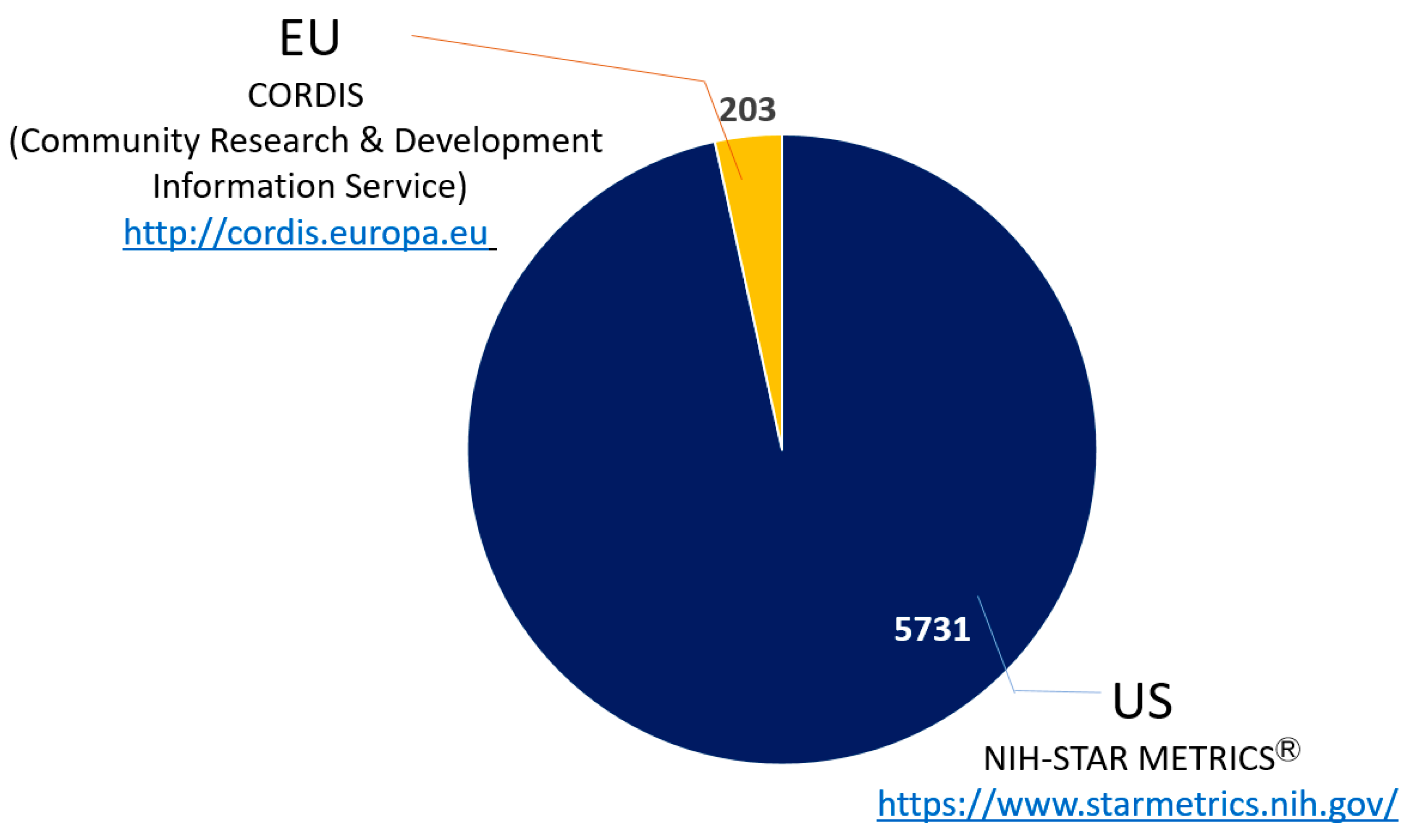
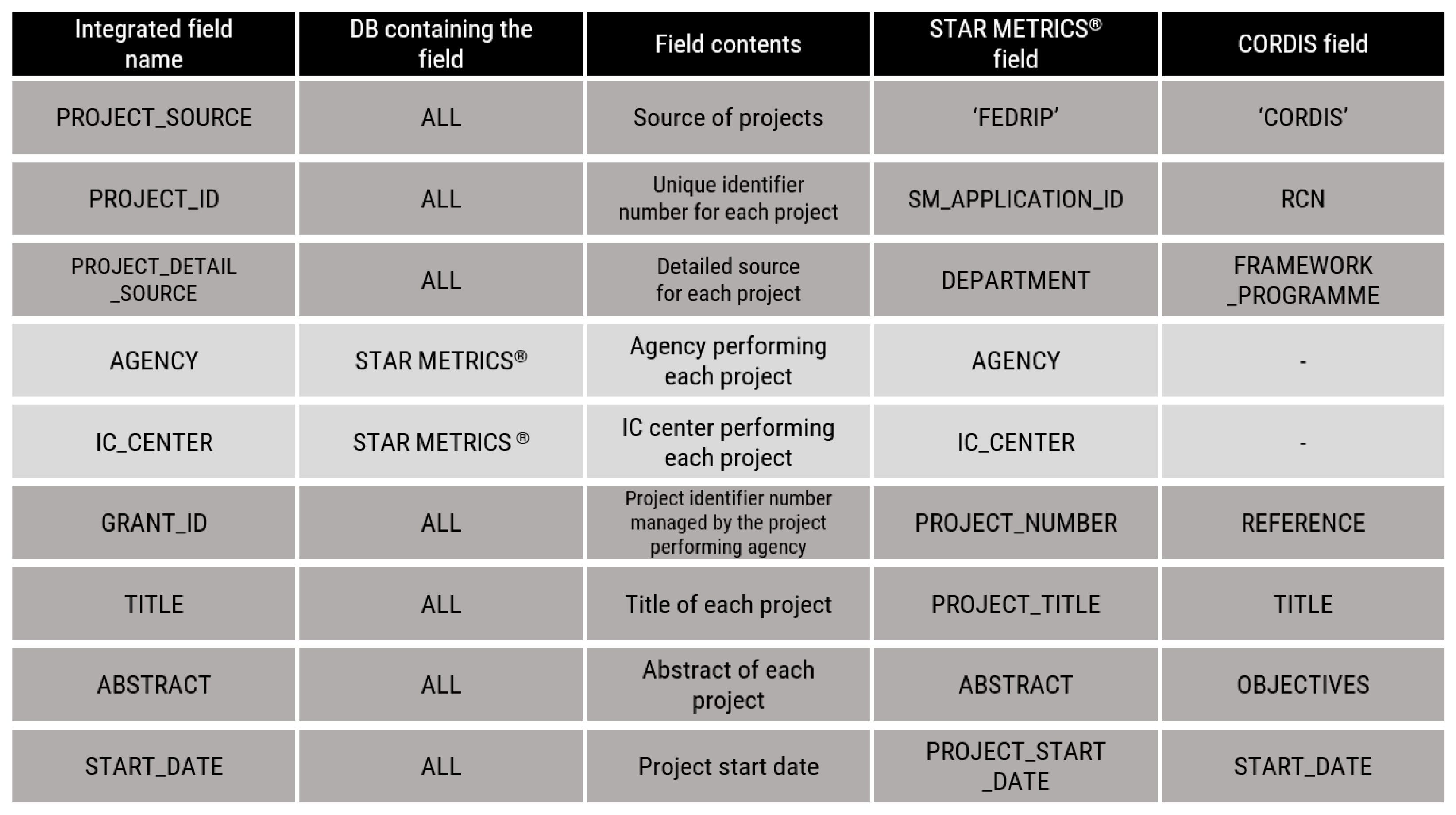
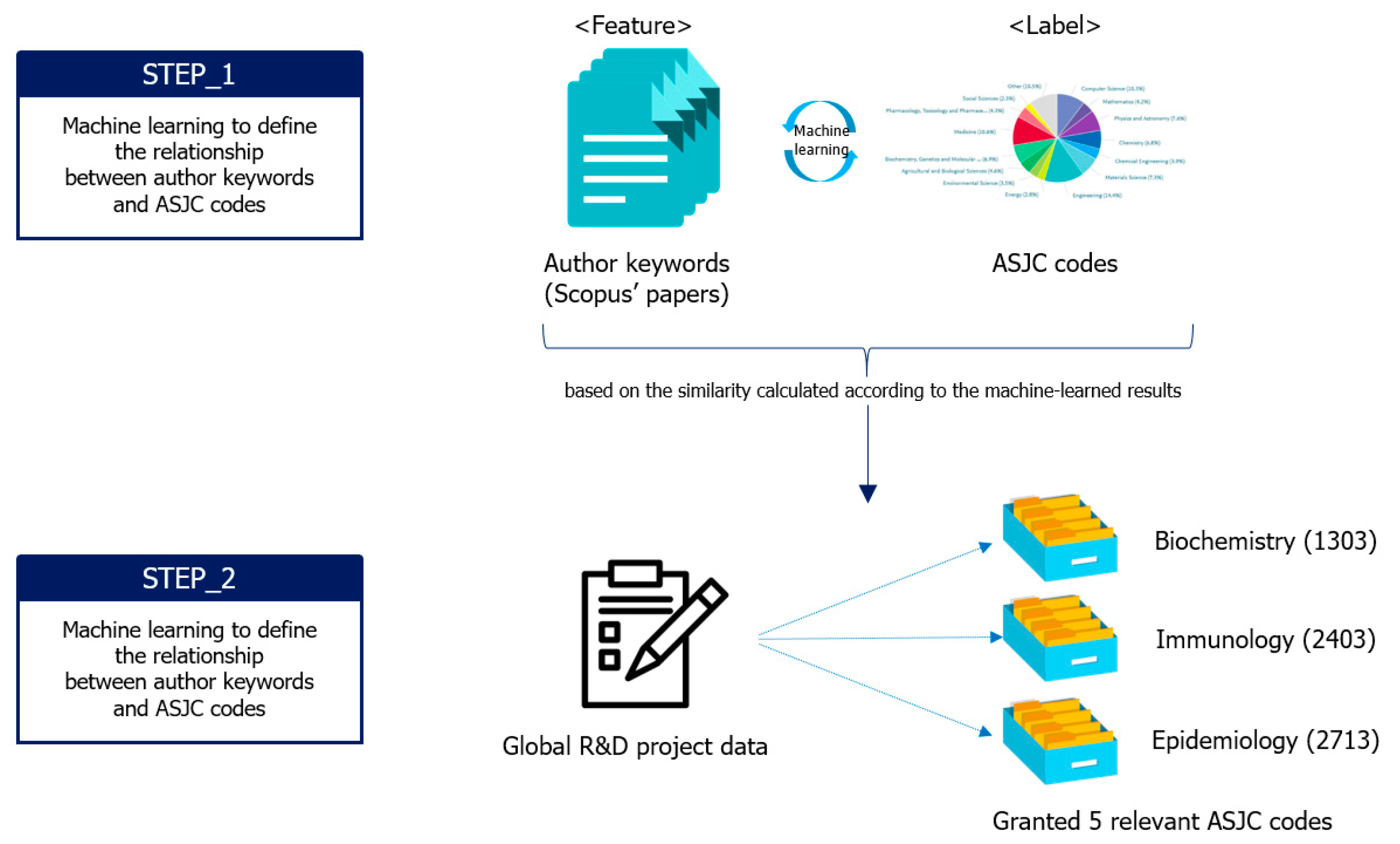
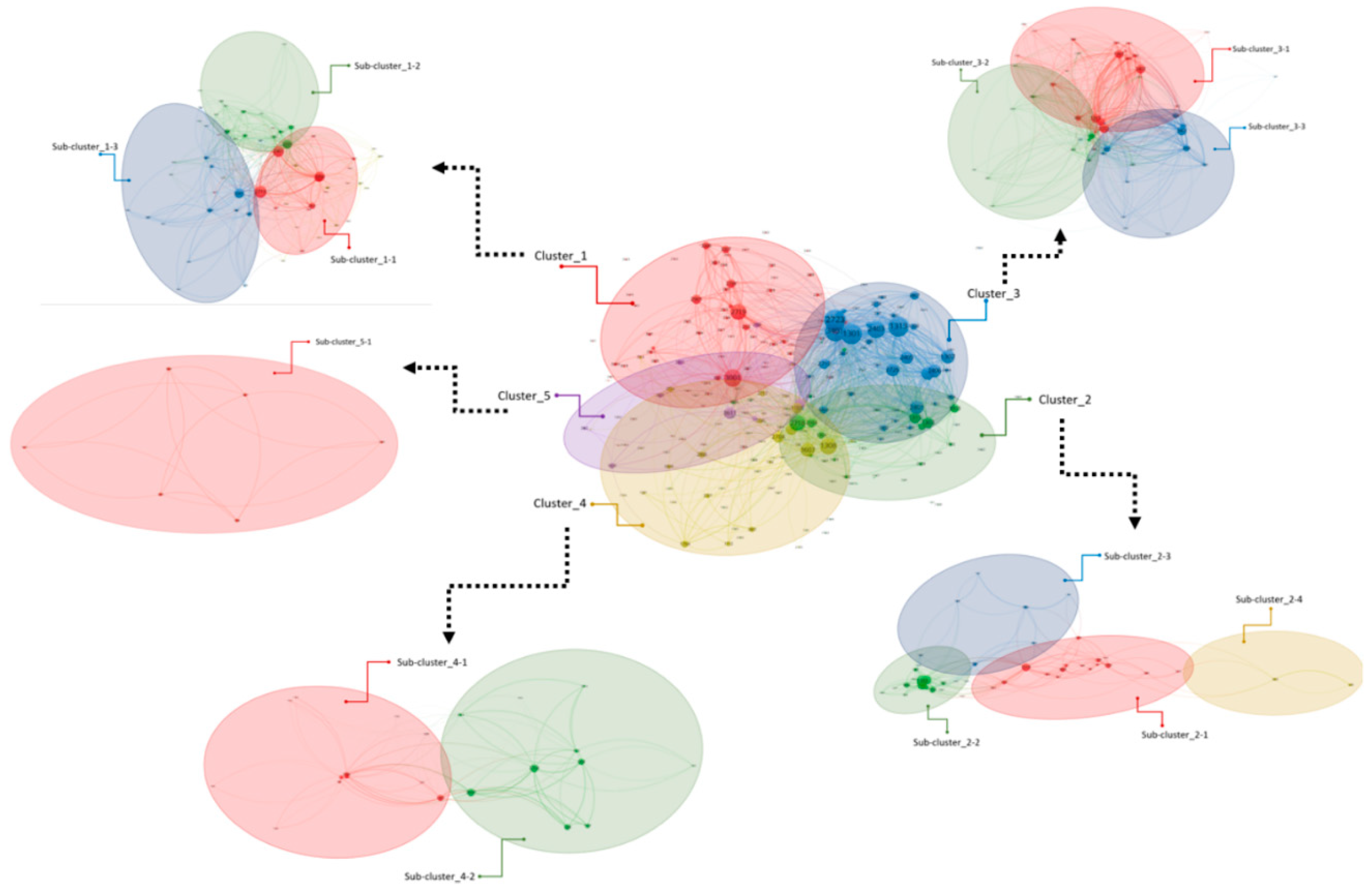
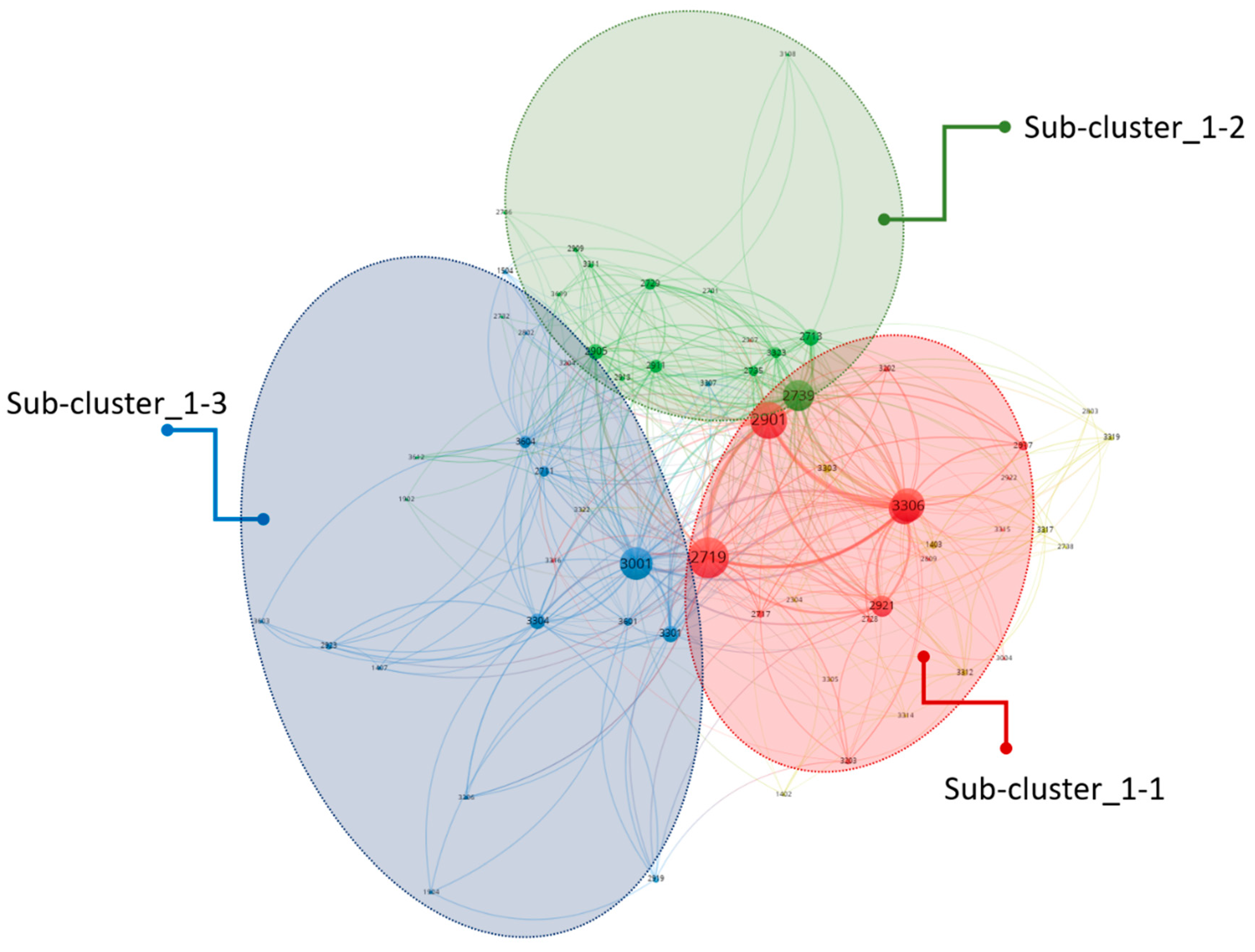

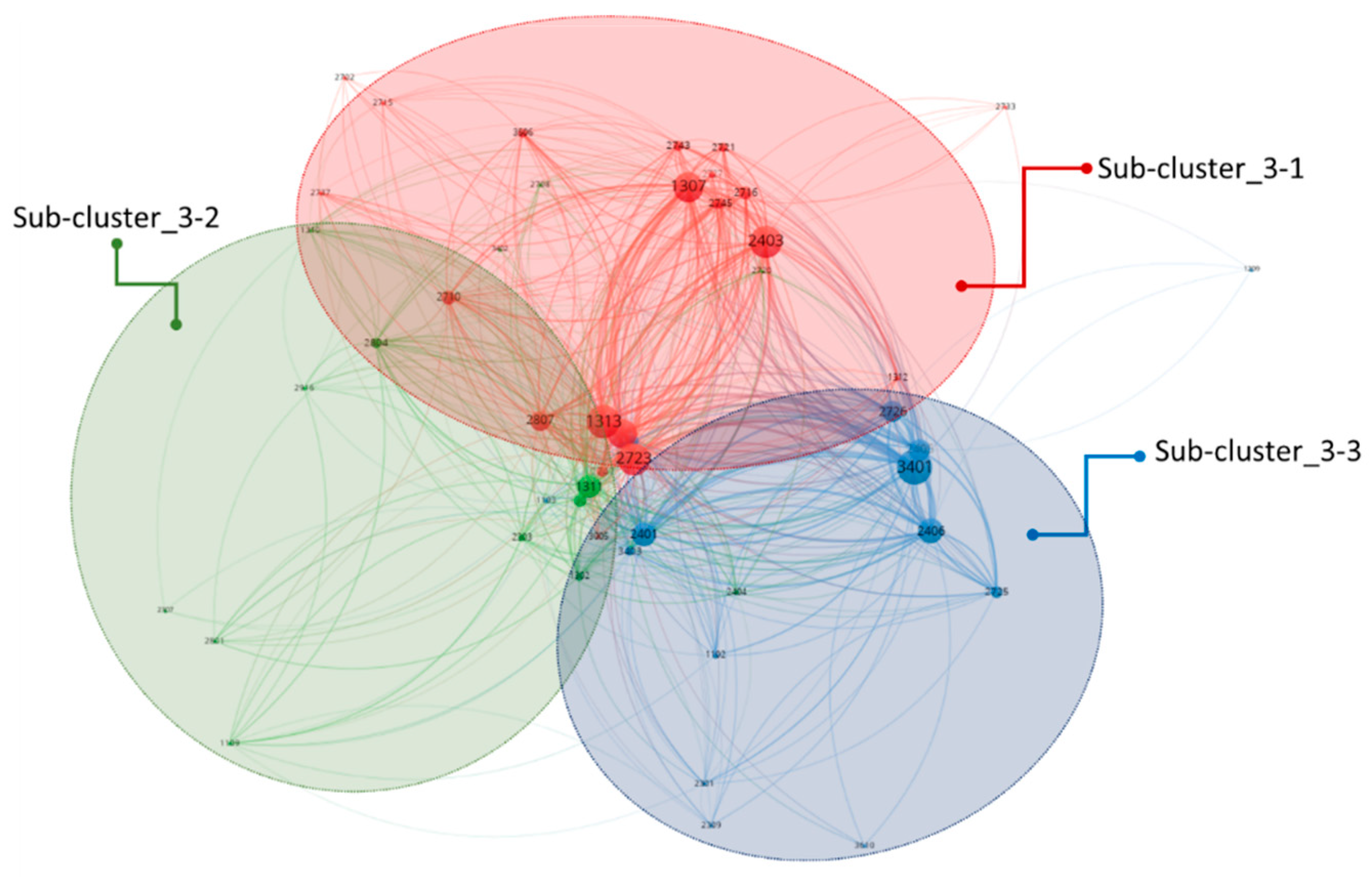
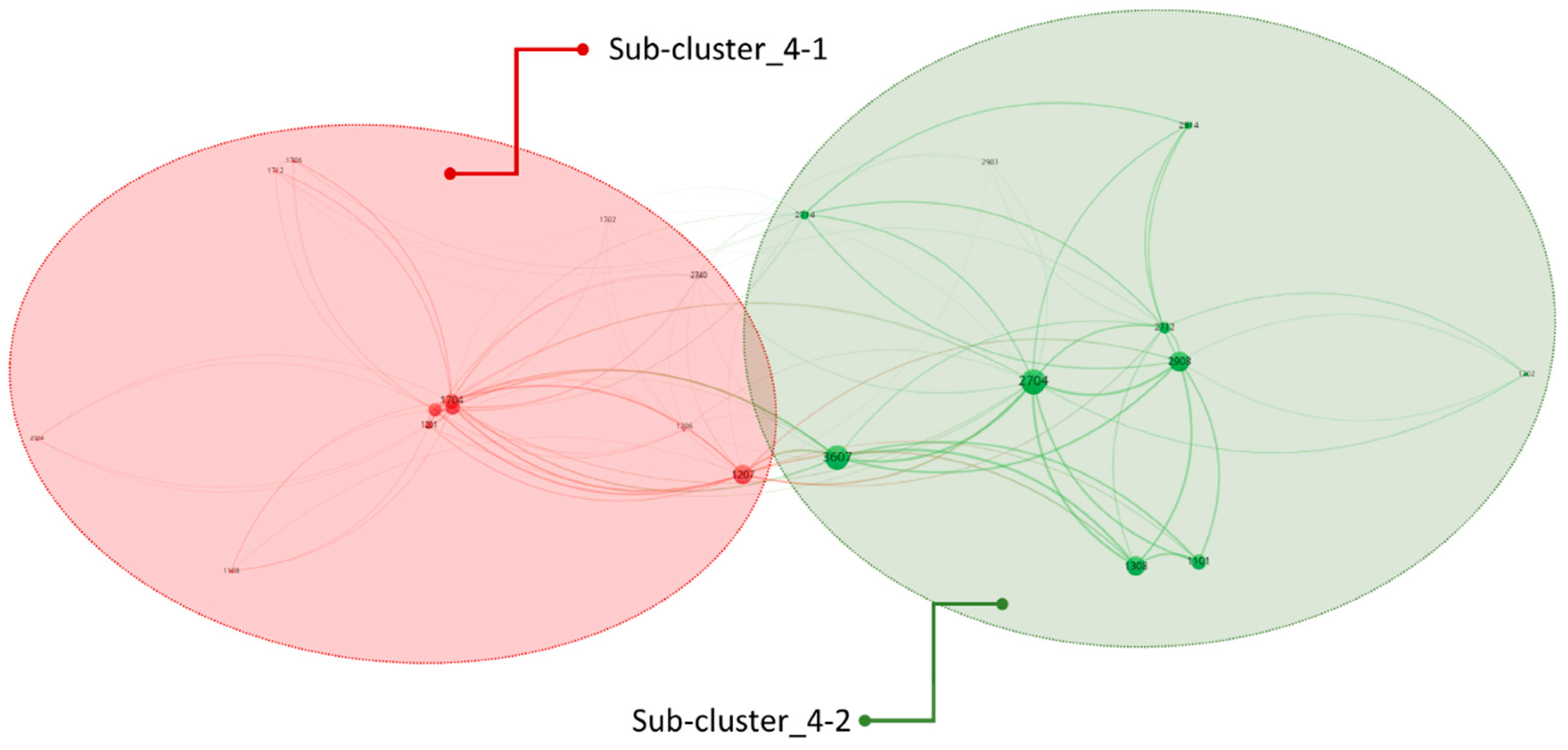
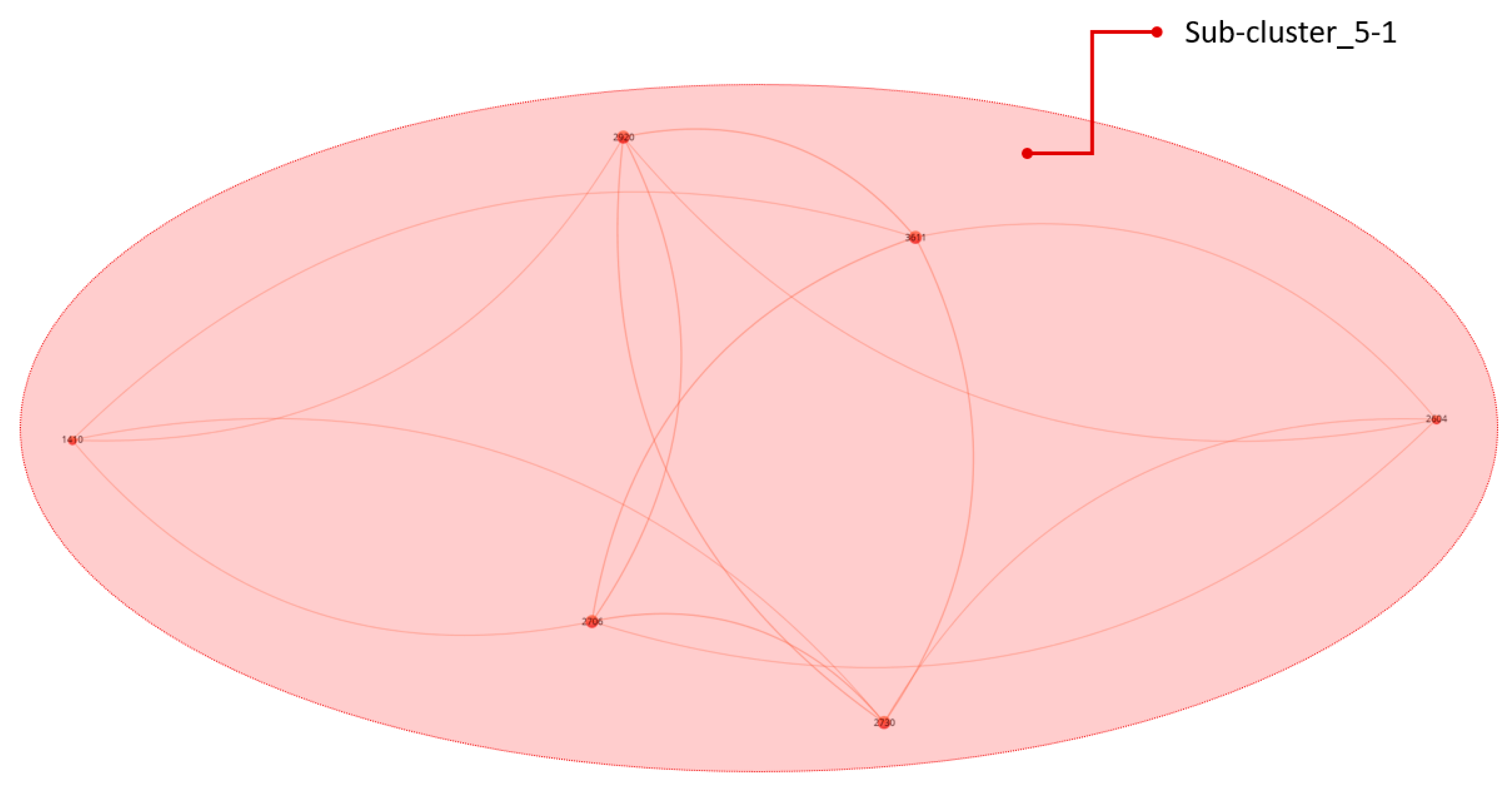
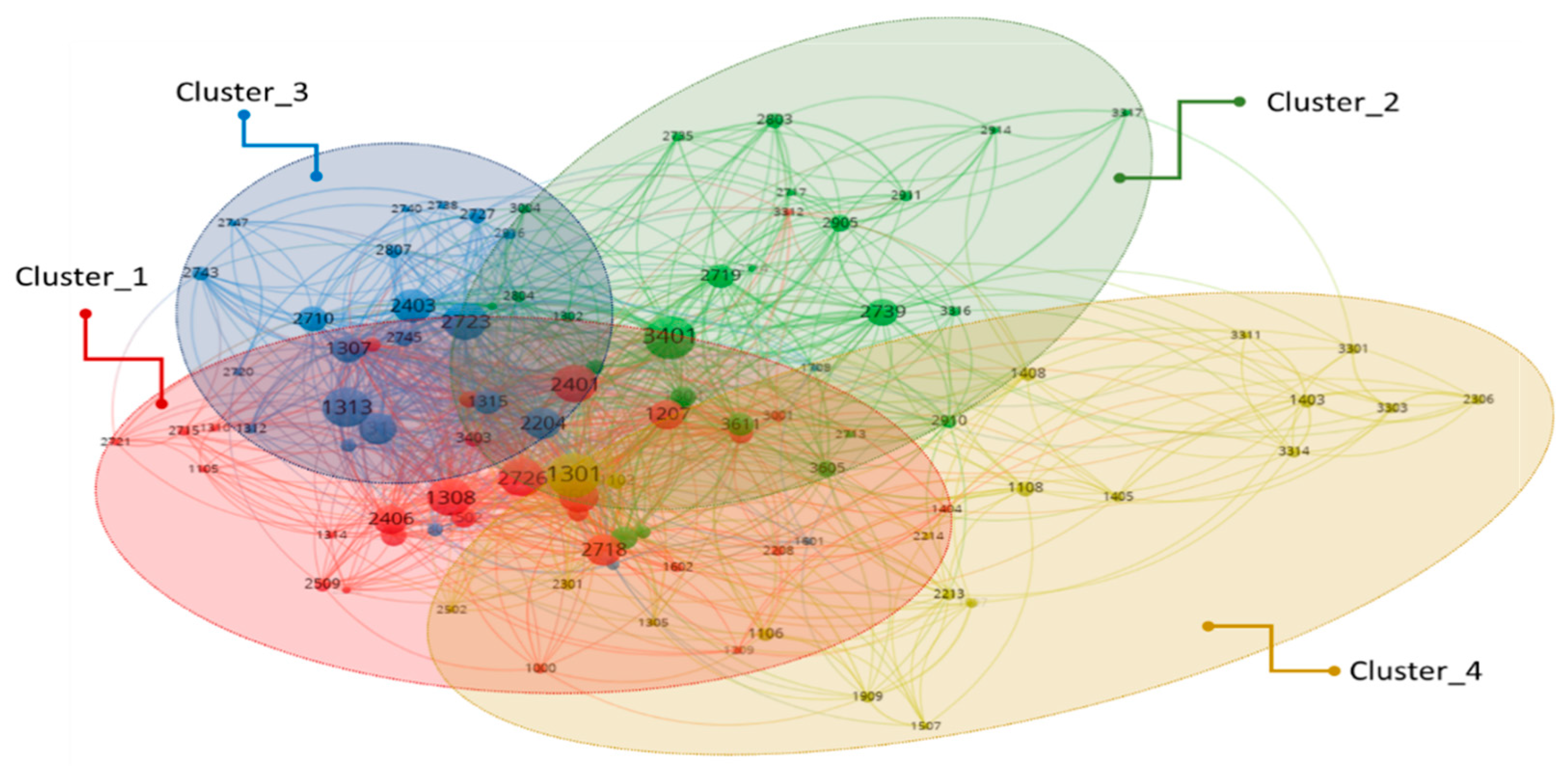
| No | COST (USD) | ORG_NAME | ASJC_CODE_5 | START_DATE | END_DATE | TITLE |
|---|---|---|---|---|---|---|
| 1-1 | 136,046 | University of North Carolina Chapel Hill | 2921;2719;3306;3207;2901 | 2015-09-23 | 2019-08-31 | Understanding Longitudinal Clinical Outcomes and Post-release Retention in Care among HIV-infected Prisoners in Lusaka Zambia |
| 1-1 | 727,222 | Yale University | 2719;3306;2921;3207;2901 | 2016-08-15 | 2021-04-30 | Addiction HIV and Tuberculosis in Malaysian Criminal Justice Settings |
| 1-1 | 181,759 | University of Chicago | 3207;3306;2719;2917;2901 | 2015-04-01 | 2018-03-31 | Public Health Targeting of Prep at HIV Positives Bridging Networks |
| 1-1 | 108,863 | Infectious Diseases Institute | 3207;3306;2719;2917;2901 | 2017-08-22 | 2022-05-31 | HIV Self Testing to Empower Prevention Choices in Sex Workers |
| 1-2 | 2,112,977 | University of Utah | 2701;2739;2729;2713;3108 | 2016-09-21 | 2018-08-31 | Early Life Exposures and Child Trajectories Growth and Respiratory Health |
| 1-3 | 185,118 | Tufts University Boston | 3601;1904;2919;3301;3304 | 2013-08-15 | 2016-07-31 | Modelling for Fidelity Mentored Dissemination of a Novel Curriculum about Infection |
| 1-3 | 109,601 | Colorado State University-Fort Collins | 3001;2923;3304;3604;3603 | 2013-07-15 | 2018-06-30 | Veterinary Pre-doctoral Research Scholars Program |
| No. | COST (USD) | ORG_NAME | ASJC_CODE_5 | START_DATE | END_DATE | TITLE |
|---|---|---|---|---|---|---|
| 2-1 | 2,330,227 | The University of Pittsburgh | 3605;2718;1710;1705;1404 | 2014-08-05 | 2019-04-30 | Modelling of Infectious Disease Agent Study(MIDAS) Informatics Services Group ISG |
| 2-1 | 747,704 | University of Utah | 3605;2718;2204;1710;3614 | 2017-08-01 | 2021-05-31 | IOBIO Web-based Interactive Tools for Real-time Analysis in Genomic Big Data |
| 2-1 | 99,552 | Research Triangle Institute | 2718;3605;1705;1701;1710 | 2014-06-01 | 2014-09-30 | MIDAS ITR Extension |
| 2-2 | 289,273 | University of Arizona | 3002;1315;1303;3003;1304 | 2016-04-01 | 2020-03-31 | Combinatorial Biosynthesis of Fungal Benzene diol Lactone Polyketides |
| 2-2 | 296,900 | University of Oklahoma | 3003;1303;1304;1607;1315 | 2017-09-15 | 2021-08-31 | Structural Transitions in Proteins and Protein Assemblies |
| 2-3 | 332,441 | Rutgers State University of New Jersey—New Brunswick | 2302;1507;2308;1508;1909 | 2016-03-15 | 2019-02-28 | UNS Dynamics of Microbial Agents in Sewer Systems and Wet Weather Flow |
| 2-4 | 399,420 | University of California San Francisco | 2705;3504;2201;1803;1408 | 2016-05-01 | 2020-04-30 | Forecasting Trachoma Control |
| No | COST (USD) | ORG_NAME | ASJC_CODE_5 | START_DATE | END_DATE | TITLE |
|---|---|---|---|---|---|---|
| 3-1 | 545,205 | H Lee Moffitt Cancer Center & Research Institute | 2747;1307;1313;2710;2723 | 2013-08-01 | 2018-04-30 | Adoptive Transfer of Donor Tregs Specific against Host Alloantigens for Presention |
| 3-1 | 345,375 | University of Arizona | 1307;2807;2403;1313;2710 | 2016-09-15 | 2021-08-31 | Modulation of Dendritic Cell Function in the Pathogenesis of Inflammatory Bowel Diseases |
| 3-1 | 620,487 | Mayo Clinic | 2721;1307;2716;1313;2715 | 2017-09-30 | 2021-06-30 | Epigenetic Mechanisms Underlying Hepatitis C-induced Hepatocarcinogenesis |
| 3-1 | 564,999 | Children’s Hospital Medical Center at Cincinnati | 1307;2743;2807;2710;2723 | 2017-09-01 | 2022-08-31 | Prenatal Inflammatory Exposures and Neonatal Immune Development |
| 3-1 | 303,140 | University of Utah | 1307;1313;2737;1306;2723 | 2017-05-15 | 2018-11-14 | Respiratory Immune Dysregulation Following Intestinal Infection |
| 3-1 | 455,611 | University of Alabama at Birmingham | 1307;2716;2723;2807;2747 | 2017-03-01 | 2022-02-28 | Specialization of Innate and Adaptive Immune Cells in Intestinal Barrier Function |
| 3-2 | 416,250 | Yale University | 2804;1309;1109;1311;2303 | 2014-03-15 | 2019-02-28 | Mechanism of Infectivity Acquisition in African Trypanosomes |
| 3-3 | 227,450 | University of California Davis | 3401;2405;2406;2725;2726 | 2016-08-16 | 2018-07-31 | Mechanisms of Increased Susceptibility to Salmonella Colonization during Malaria |
| 3-3 | 349,968 | University of Washington | 3401;2301;2405;2726;2725 | 2017-08-16 | 2020-05-31 | Impact of Malaria Coinfection on HIV Vaccination |
| 3-3 | 895,500 | Agricultural Research Service | 2401;2406;3403;2301;2726 | 2014-04-17 | 2017-04-30 | Predictive Biology of Emerging Vector-borne Viral Diseases |
| No. | COST (USD) | ORG_NAME | ASJC_CODE_5 | START_DATE | END_DATE | TITLE |
|---|---|---|---|---|---|---|
| 4-1 | 1,080,000 | Georgetown University | 1704;1201;2601;1108;2707 | 2016-04-12 | 2017-03-14 | Task D13 Woodchuck Animal Model for Testing Hepatitis B Virus Therapeutics |
| 4-1 | 813,138 | Utah State University | 1704;2601;1108;1207;1201 | 2017-01-11 | 2018-01-10 | Task A105 Small Animal Models for Biodefense Viruses |
| 4-2 | 656,961 | Louisiana State Office of Public Health | 1308;2704;3607;2908;1101 | 2014-08-01 | 2019-07-31 | Epidemiology and Laboratory Capacity for Infectious Diseases (ELC)—Building and Strengthening Epidemiology Laboratory and Health Information Systems Capacity in State and Local Health Departments |
| 4-2 | 2,242,886 | New York City Health/Mental Hygiene | 2704;2908;2712;2714;2914 | 2014-08-01 | 2019-07-31 | Nycdohmh Pphf 2014 Epidemiology and Laboratory Capacity for Infectious Diseases (ELC) |
| 4-2 | 487,936 | Virgin Islands Department of Health | 2704;2908;2712;2714;2914 | 2014-08-01 | 2019-07-31 | Epidemiology and Laboratory Capacity for Infectious Diseases |
| No. | COST (USD) | ORG_NAME | ASJC_CODE_5 | START_DATE | END_DATE | TITLE |
|---|---|---|---|---|---|---|
| 5-1 | 26,886 | Saint Louis University | 3611;2920;2730;1410;2706 | 2016-07-12 | 2017-07-11 | Vaccine and Treatment Evaluation Unit Clinical Operations Support for Influenza Vaccine Studies |
| 5-1 | 53,270 | University of Iowa | 3611;2730;2920;2706;2604 | 2015-07-13 | 2016-10-01 | VTEU Clinical Trial Operations Support |
| No. | COST (USD) | ORG_NAME | ASJC_CODE_5 | START_DATE | END_DATE | TITLE |
|---|---|---|---|---|---|---|
| 1 | 205,891 | Erasmus Universitair Medisch Centrum Rotterdam | 3403;2704;2401;3607;2406 | 2014-07-01 | 2016-06-30 | Early Detection of Emerging Viruses by Next Generation in Situ Hybridization |
| 1 | 83,572 | Millidrop Instruments SAS | 2726;2402;1308;1502;3607 | 2017-08-01 | 2018-01-31 | New Millidrop Analyzer Miniaturized and Faster Clinical Microbiology Testing in Only One Drop |
| 1 | 2,924,954 | University of Oslo | 2401;2718;1404;1207;2208 | 2017-08-01 | 2022-07-31 | Scalable Inference Algorithms for Bayesian Evolutionary Epidemiology |
| 1 | 4,042,309 | Cy.R.I.C Cyprus Research and Innovation Center Ltd. | 1308;2704;2726;3403;3607 | 2017-11-01 | 2021-04-30 | Swine Diseases Field Diagnostics Toolbox |
| 1 | 1,987,741 | Ecole Polytechnique Federale de Lausanne | 2401;1314;2406;1105;2721 | 2013-02-01 | 2018-01-31 | Virulence Factors of Facultative Pathogens and their Role outside the Human Host |
| No. | COST (USD) | ORG_NAME | ASJC_CODE_5 | START_DATE | END_DATE | TITLE |
|---|---|---|---|---|---|---|
| 2 | 2,865,869 | King’s College London | 2717;3317;2739;2905;2914 | 2014-08-01 | 2019-07-31 | 10/66 Ten Years on Monitoring and Improving Health Expectancy by Targeting Frailty Among Older People in Middle Income Countries |
| 2 | 12,826,010 | Medicines and Healthcare Products Regulatory Agency | 3401;2736;3611;2719;2905 | 2013-11-01 | 2017-10-31 | European Research Infrastructures for Poverty Related Diseases |
| 2 | 12,401,992 | European Vaccine Initiative—EEIG | 3401;2719;2905;2910;3316 | 2017-05-01 | 2022-04-30 | European Vaccine Research and Development Infrastructure |
| 2 | 34,130,994 | The University of Edinburgh | 2739;3401;2719;2910;2713 | 2017-01-01 | 2021-12-31 | Respiratory Syncytial Virus Consortium in Europe |
| No. | COST (USD) | ORG_NAME | ASJC_CODE_5 | START_DATE | END_DATE | TITLE |
|---|---|---|---|---|---|---|
| 3 | 1,751,490 | Tel Aviv University | 1309;1313;1315;2710;2727 | 2015-07-01 | 2020-06-30 | A Genetic View of Influenza Infection |
| 3 | 1,754,713 | Universitaet Zuerich | 1313;1307;2807;1103;1315 | 2016-06-01 | 2021-05-31 | How Infection History Shapes the Immune System Pathogen-induced Changes in Regulatory T-Cells |
| 3 | 114,341 | Cardiff University | 1307;2723;1312;2403;2743 | 2017-09-01 | 2018-08-31 | Innate-Like T-Cells in Sepsis (ILTIS) Implications for Early Diagnosis and Rescue of Immune Suppression. |
| 3 | 1,754,861 | Academisch Ziekenhuis Groningen | 1307;2710;2916;2723;2743 | 2017-04-01 | 2022-03-31 | The Role of the Virome in Shaping the Gut Ecosystem during the First Year of Life |
| 3 | 3,653,371 | Universita’ Degli Studi Di Milano-Bicocca | 2723;1307;2403;1313;2743 | 2015-01-01 | 2018-12-31 | Toll-Like Receptor 4 Activation and Function in Diseases: an Integrated Chemical-biology Approach |
| 3 | 2,328,446 | Medical Research Council | 1313;2204;2727;1309;1311 | 2017-10-01 | 2022-09-30 | Understanding the Complexity and Architecture in Protein Ubiquitination |
| No. | COST (USD) | ORG_NAME | ASJC_ CODE_5 | START_ DATE | END_ DATE | TITLE |
|---|---|---|---|---|---|---|
| 4 | 1,243,357 | University of Strathclyde | 2502;1301;2404;2725;2730 | 2016-06-01 | 2020-05-31 | Leveraging Pharmaceutical Sciences and Structural Biology Training to Develop 21st Century Vaccines |
| 4 | 3,057,009 | Universita degli Studi di Trento | 1301;1405;1403;2730;3002 | 2014-06-01 | 2019-05-31 | Outer Membrane Vesicles OMVs from Vaccinobacter: A Synthetic Biology Approach for Effective Vaccines against Infectious Diseases and Cancer |
| 4 | 1,506,843 | University College Cork, National University of Ireland, Cork | 1301;2741;2404;2502;2725 | 2014-10-01 | 2018-09-30 | Vaccines and Imaging Partnership |
| 4 | 8,973,217 | Academisch Medisch Centrum—Universiteit Van Amsterdam | 1301;2404;2405;2724;2725 | 2013-10-01 | 2017-09-30 | Developing and Testing a Novel Low-cost Effective Hookworm Vaccine to Control Human Hookworm Infection in Endemic Countries |
© 2019 by the authors. Licensee MDPI, Basel, Switzerland. This article is an open access article distributed under the terms and conditions of the Creative Commons Attribution (CC BY) license (http://creativecommons.org/licenses/by/4.0/).
Share and Cite
Heo, Y.; Kang, J.; Kim, K. National Scientific Funding for Interdisciplinary Research: A Comparison Study of Infectious Diseases in the US and EU. Sustainability 2019, 11, 4120. https://doi.org/10.3390/su11154120
Heo Y, Kang J, Kim K. National Scientific Funding for Interdisciplinary Research: A Comparison Study of Infectious Diseases in the US and EU. Sustainability. 2019; 11(15):4120. https://doi.org/10.3390/su11154120
Chicago/Turabian StyleHeo, Yoseob, Jongseok Kang, and Keunhwan Kim. 2019. "National Scientific Funding for Interdisciplinary Research: A Comparison Study of Infectious Diseases in the US and EU" Sustainability 11, no. 15: 4120. https://doi.org/10.3390/su11154120
APA StyleHeo, Y., Kang, J., & Kim, K. (2019). National Scientific Funding for Interdisciplinary Research: A Comparison Study of Infectious Diseases in the US and EU. Sustainability, 11(15), 4120. https://doi.org/10.3390/su11154120





